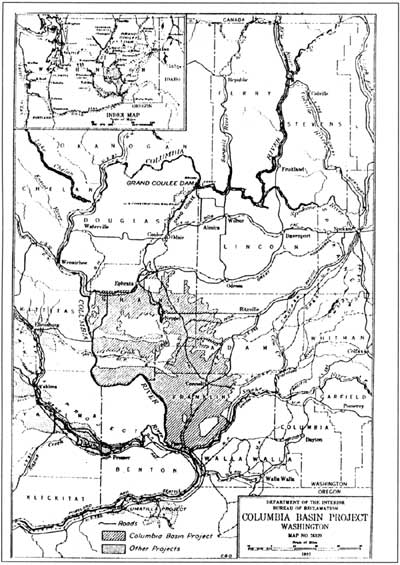|
Lake Roosevelt
Administrative History |

|
CHAPTER 2:
The River Becomes a Lake (continued)
Grand Coulee Dam from World War II to Present
Total construction costs of reservoir (Lake Roosevelt)
for:
-- Hall, Final Construction Report, 1952 |
Grand Coulee Dam was completed just in time to help with the war effort. During World War II, power from the dam went to defense programs such as aluminum production for airplanes and the Hanford project developing plutonium for atomic bombs. The rapid industrial expansion and population growth that the Pacific Northwest experienced due to the war guaranteed a market for the electricity that some had predicted would become an embarrassing surplus. [36]
While Grand Coulee Dam was under construction, plans moved ahead for the larger Columbia Basin Irrigation Project, the largest single reclamation project ever undertaken in the country. In 1933, the state formed the Columbia Basin Commission to promote the general plan for the dam, storage reservoir, pumping plant, canals, and other elements of the irrigation plan. The upper Grand Coulee's "equalizing reservoir" was created to store water pumped some three hundred feet up from the lake behind Grand Coulee Dam. This water was then available to be distributed for irrigation. This thirty-mile-long reservoir, named Banks Lake in 1958 in memory of Reclamation engineer Frank Banks, was first filled with water in 1951. The irrigation network was never fully completed to the extent envisioned in the 1930s, however. Today, the project irrigates over 556,000 acres covering an area of about 60 by 120 miles (about half the amount possible for the entire project). [38]
One more round of large-scale construction occurred at Grand Coulee Dam later in the twentieth century. Construction of the third powerhouse, authorized by Congress in 1966, required the removal of a section of the original dam's east end. The finished building could hold twelve generators; the first six went on line between 1975 and 1980. The new power plant allowed Reclamation to double its irrigation flow from Banks Lake. It also allowed Grand Coulee Dam to become a "peaking plant" as well as a day-to-day power producer, coming on and going off during each day depending on the demand for power. Power generated at Grand Coulee Dam is fed into the Pacific Northwest Power Grid maintained by BPA and is sold to Washington, Oregon, Idaho, and parts of Montana and California. In addition, ties to other grids allow power to be sold outside the region. [39]
The construction of Grand Coulee Dam had far-reaching effects in many realms besides power generation and irrigation. The creation in the late 1930s of a reservoir where there had once been a river dramatically affected the lives of many living in the area. The lake also created new recreational opportunities, leading to the establishment of a national recreation area to serve both local residents and visitors.
| <<< Previous | <<< Contents >>> | Next >>> |
laro/adhi/adhi2c.htm
Last Updated: 22-Apr-2003
